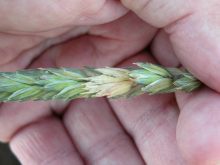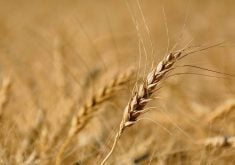Should falling number and deoxynivalenol (DON) be official grain-grading factors?
The Canadian Grain Commission (CGC) is asking the grain industry for opinions before May 10.
Both factors are included now, but through visual proxies — sprout damage for falling number and fusarium-damaged kernels for DON. They aren’t as accurate as machine measurements, but they are cheaper and faster.
“We know they (visual measurements) have served producers and the industry well, but should we be making improvements?” CGC corporate information services manager Remi Gosselin said in an interview.
Read Also

Manitoba sclerotinia picture mixed for 2025
Variations in weather and crop development in this year’s Manitoba canola fields make blanket sclerotinia outlooks hard to pin down
The Alberta Wheat Commission (AWC) and Western Grain Elevator Association (WGEA) support objective testing in principle, but only when practical, saying benefits have to outweigh the cost.
AWC general manager Tom Steve and WGEA executive director Wade Sobkowich both questioned the timing given the Canada Grain Act and the CGC are under review.
The CGC and Agriculture and Agri-Food Canada announced the review March 15 in Montreal during a closed-door meeting of the Grains Roundtable meeting.
Testing equipment expensive
DON levels have traditionally been measured in laboratories, but lateral flow strip technology is simple, fast and cost effective, a CGC discussion paper says.
The falling number test measures an enzyme called alpha-amylase, which is triggered by sprout damage and reduces the ability of bread to rise. The test, usually done in a laboratory, measures the time a plunger drops through a slurry of water and wheat flour. The more alpha-amylase the less viscous the slurry and the faster the plunger falls, resulting in a lower falling number.
“It’s important to note there are no predetermined outcomes and no decisions have been made,” Gosselin said, adding that’s why it’s a ‘discussion’ rather than a ‘consultation.’
If falling number and DON become grading factors the CGC could arbitrate disputes between farmers and grain buyers as it does now on other grading factors under ‘subject to inspector’s grade and dockage’ provisions in the grain act, Gosselin said.
“The other reason is grain-pricing transparency,” he said. “If it’s being used in transactions between grain companies and grain buyers, some people would argue they should be used in assessing the value of grain at delivery (by farmers).”
A CGC-led experiment in 2006-07 using Rapid Visco Analyzers (RVA) in elevators to measure alpha-amylase showed the machines were inaccurate, at least in an elevator setting as opposed to a laboratory, and are expensive at about $50,000 each.
Support for change
In 2004 the Keystone Agricultural Producers (KAP) passed a resolution in favour of using falling number. In 2018 the AWC and Western Canadian Wheat Growers Association also supported the idea.
Two of the last three Alberta harvests have been wet, Steve said.
“The falling number test in many cases verified it was milling wheat (even though sprout damage didn’t),” he said.
Still, the AWC has questions.
“Would it be a driveway test, for example? That has a lot of cost implications and speed implications for handling system,” Steve said. “We need to know a lot more about the nature of what the discussion is before we could take a formal position.”
The WGEA didn’t ask for the changes, Sobkowich said.
“Where it’s practical to test and get results on the driveway for farmers we generally support that in principle,” he said.
WGEA members, who include Canada’s major grain companies, buy wheat from farmers based on the current visual system, but exports using falling number and DON when asked to by customers, Sobkowich said.
Making falling number and DON grading factors wouldn’t result in any additional revenue to grain companies and would probably add costs, he said.
“So we have to weigh that against what the added costs might be to the system… and understand if there’s a net benefit or a net cost to the handling system, the grain sector, to farmers,” Sobkowich said.
“There will be winners and losers,” he said because machine testing would sometimes return more money to farmers than visual grading and vice versa.
If sprout damage and falling number were both grading factors, which the discussion paper (www.grainscanada.gc.ca) says could be an option, there would be two ways for wheat to be downgraded, Sobkowich said.
“I think a lot of people think falling number is a replacement for other grading factors. They think ‘since it has good falling number therefore I should get a No. 1.’ I think people don’t understand. It’s not a replacement for other degrading factors.”
SaskWheat is reviewing the issue and will take part in the discussion, but hasn’t formed a position yet, general manager Harvey Brooks said in an email.
As in Canada, falling number and DON are not part of official grades in the United States, but they do affect the prices paid to farmers, the CGC paper says.




















